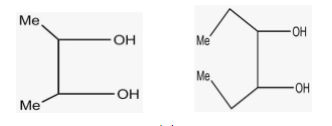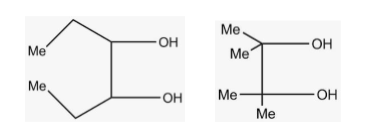
The increasing order of rate of oxidation with
(I.) (II.)

(III) (IV)

A.
B.
C.
D.


Answer
494.4k+ views
Hint:
Complete step by step answer:
More the steric hindrance, lesser is the oxidation. The correct increasing order for oxidation according to the figure is
1, 2 or vicinal diols are cleaved by periodic acid,
-The heavier the diol less chance to undergo oxidation by
-This option is absolutely correct according to the question because there is no bulkier group attached to the compound of fig I. so, there is no steric hindrance and rate of oxidation is fast in fig I.
-This option is not correct as it shows the reverse of the correct answer. Heavier diol is shown in fig IV so the oxidation is less. But in this option, oxidation is shown more in fog IV.
-This option shows that the rate of oxidation is equal for III and I which is not correct at all as it does go in the favour of what we studied. So, this option is incorrect.
-This option also does not go correct with the question because it shows that rate of oxidation is equal for II and III in fact the order is also not right.
Note:
Vicinal diols are cleaved by periodic acid to yield aldehydes or ketones depending on the number of substituents on the carbon atoms. Diols provides an alternative method to ozonolysis of alkenes. Steric hindrance is the retardation of a chemical reaction caused by the arrangement of atoms in a molecule.
Complete step by step answer:
More the steric hindrance, lesser is the oxidation. The correct increasing order for oxidation according to the figure is
1, 2 or vicinal diols are cleaved by periodic acid,
-The heavier the diol less chance to undergo oxidation by
-This option is absolutely correct according to the question because there is no bulkier group attached to the compound of fig I. so, there is no steric hindrance and rate of oxidation is fast in fig I.
-This option is not correct as it shows the reverse of the correct answer. Heavier diol is shown in fig IV so the oxidation is less. But in this option, oxidation is shown more in fog IV.
-This option shows that the rate of oxidation is equal for III and I which is not correct at all as it does go in the favour of what we studied. So, this option is incorrect.
-This option also does not go correct with the question because it shows that rate of oxidation is equal for II and III in fact the order is also not right.
Note:
Vicinal diols are cleaved by periodic acid to yield aldehydes or ketones depending on the number of substituents on the carbon atoms. Diols provides an alternative method to ozonolysis of alkenes. Steric hindrance is the retardation of a chemical reaction caused by the arrangement of atoms in a molecule.
Recently Updated Pages
Master Class 12 Business Studies: Engaging Questions & Answers for Success

Master Class 12 English: Engaging Questions & Answers for Success

Master Class 12 Social Science: Engaging Questions & Answers for Success

Master Class 12 Chemistry: Engaging Questions & Answers for Success

Class 12 Question and Answer - Your Ultimate Solutions Guide

Master Class 12 Economics: Engaging Questions & Answers for Success

Trending doubts
Most of the Sinhalaspeaking people in Sri Lanka are class 12 social science CBSE

Give 10 examples of unisexual and bisexual flowers

Draw a labelled sketch of the human eye class 12 physics CBSE

Differentiate between homogeneous and heterogeneous class 12 chemistry CBSE

Write a short note on Franklands reaction class 12 chemistry CBSE

Differentiate between insitu conservation and exsitu class 12 biology CBSE




